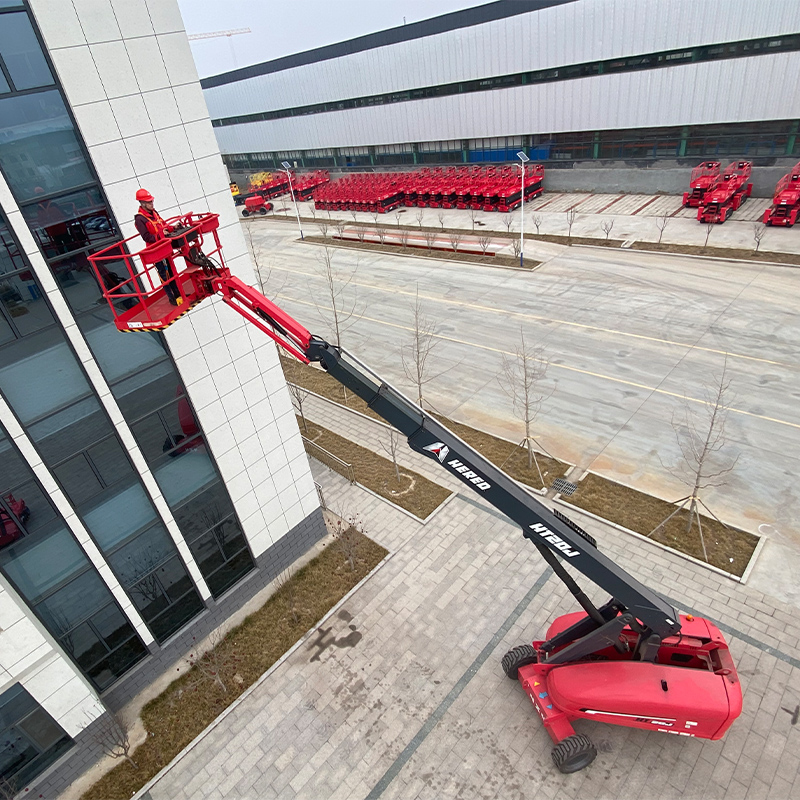Boom Lift vs. Telehandler
Aerial lifts come in various shapes and sizes, each designed for specific tasks. Among the most commonly used types are boom lifts and telehandlers. If you frequently work with aerial lifts, chances are you’ve encountered both. Knowing the key differences between a boom lift and a telehandler will help you choose the right equipment for the job.
Boom Lifts vs. Telehandlers: Key Differences and Uses
A boom lift, sometimes called a zoom boom lift, is an elevated work platform designed to lift workers, materials, and essential job supplies. It includes various types of aerial work platforms and lifting equipment, such as:
- Telehandlers
- Cherry Pickers
- Articulating Boom Lifts – Jointed design with flexible positioning for greater reach
- Telescopic Boom Lifts – Straight boom with extendable height options
- Telescopic Forklifts
So what is a telehandler, exactly? It’s a special type of boom lift, and it has multiple moving joints and can be moved both horizontally (side to side) and vertically (up and down). On top of that, a telehandler has customized attachments, so it provides more versatility in comparison to a standard boom lift.
Types of Telehandlers and Boom Lifts
Telehandlers
Telehandlers come in two main types:
- Standard Fixed Boom Telehandlers – These have a limited range of motion and are commonly used in construction and agriculture.
- Rotating Telehandlers – Featuring a cab and body that can rotate up to 360° while the base remains stationary, these offer greater flexibility for various job sites.
Additionally, telehandlers are available in compact, heavy-lift, and rough-terrain models, designed to handle specialized applications.
Boom Lifts (Zoom Boom Lifts)
Boom lifts, also known as zoom booms, are categorized into three main types:
1. Articulating Boom Lift (Knuckle Boom)
An articulating boom lift features a jointed arm with a swiveling turntable, providing both vertical and horizontal reach.
- Maximum vertical reach: Up to 125 ft
- Horizontal extension: Up to 75% of its height
- Suitable for indoor and outdoor applications
- Available in electric and diesel-powered models
2. Telescopic Boom Lift (Stick Boom)
A telescopic boom lift extends in a straight line with a bucket at the end of its arm. Operators control its horizontal extension before adjusting the arm’s vertical height.
- Maximum vertical reach: Up to 185 ft
- Ideal for building maintenance, cleaning, and repairs at high elevations
- Easier to operate than articulating boom lifts due to its single-boom design
3. Atrium Lift
An atrium lift is a type of articulating boom lift, but instead of wheels, it features tracks similar to those on excavators.
- Well-suited for rough terrain
- Narrow and lightweight compared to other boom lifts
- Maximum vertical reach: 60 ft
Choosing the right telehandler or boom lift depends on your specific job requirements, terrain conditions, and reach needs.
Which Equipment Best Suits Your Work Duties?
When comparing a standard telehandler to a boom lift for job site applications, it's essential to understand their unique functions.
A telehandler is primarily used for lifting, moving, and placing materials such as bricks, gravel, and lumber. Its versatility depends largely on the attachments used. By selecting the right attachments, businesses can maximize the telehandler’s efficiency across various tasks.
A boom lift, on the other hand, is designed to elevate workers and materials to reach high or hard-to-access areas. Certain boom lift models allow operators to maneuver around obstacles and corners, making them ideal for tasks requiring precision at height.
Boom lifts also serve as an alternative to scissor lifts. While both enable work at elevated heights, boom lifts generally offer greater maneuverability. However, they come with some limitations:
- Limited Capacity – Most boom lifts have small platforms that accommodate only one or two workers along with their tools, making them less practical for large-scale projects.
- Weather Sensitivity – Since boom lifts rely on hydraulics, extreme weather conditions can impact their functionality.
- Training Requirements – Operating a boom lift requires specialized training, which can add to the overall project costs.
Choosing between a telehandler and a boom lift depends on the specific needs of your worksite. A telehandler is best for material handling versatility, while a boom lift is ideal for precise work at heights.
Telehandler vs. Boom Lift Attachments
Selecting the right attachments for a telehandler can significantly impact efficiency and safety. When choosing between a telehandler and a boom lift, the available attachments play a crucial role in maximizing productivity.
Common Telehandler Attachments:
- Forks – Transform a telehandler into a forklift for high-reach applications.
- Lifting/Rigging Hooks – Ideal for hoisting and securing loads.
- Buckets – Useful for construction tasks, such as moving earth and debris.
- Swivel Hooks – Enhance maneuverability when lifting materials.
- Spreader Bars – Provide stability for handling large or awkward loads.
- Standard Work Platforms – Support safe and efficient elevated work.
- Lifting Jib – A versatile tool for heavy lifting and rigging.
- Trash Hoppers – Facilitate easy material disposal on job sites.
Common Boom Lift Attachments:
- Spill Guards – Help contain materials and prevent spills.
- Tool Trays – Provide convenient storage for tools and equipment.
- Panel Cradles – Securely hold large panels during installation.
- Control Box Covers – Protect controls from dust, debris, and weather conditions.
- Auxiliary Rails – Enhance safety by providing additional railing support.
Telehandler vs. Boom Lift FAQs
1. What is the difference between a boom lift and an aerial lift?
A boom lift is a specific type of aerial lift that uses a telescoping or articulating arm to elevate workers or equipment to high locations. In contrast, aerial lifts, such as cherry pickers, include various lift types designed to access elevated areas that would otherwise be difficult or impossible to reach.
2. What are the two types of boom lifts?
Boom lifts come in two main types:
- Telescopic Boom Lifts – Feature a straight, extendable arm that provides a higher reach with a stable platform.
- Articulating Boom Lifts – Have multiple jointed sections, allowing for more flexible movement and access to hard-to-reach areas.
3. Is a telehandler the same as a zoom boom?
No, a telehandler is a versatile lifting machine equipped with an extendable boom arm, commonly used for lifting and placing heavy loads at various heights. A zoom boom is often used interchangeably with "telehandler," but it generally refers to models with extended reach and increased load capacity.
Let me know if you'd like any further refinements!





